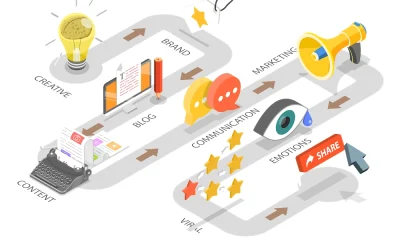Marketing
Return of the Expo and Trade Show

Businesses love these large-scale events for the in-person selling opportunities. And let’s face it, while we all love being online and using video conferencing, they’re no substitute for the high sensory experience of meeting customers face to face.
When expos were at their height of popularity, a high proportion of deals can trace their origins to these so-called ‘fortuitous meetings’, and they were fun for attendees and exhibitors.
It’s time to strategize your next exhibition, which should include technologies for a targeted digital experience for deeper engagement with customers.
How To Stand Out At A Trade Show
Trade Shows have always been highly charged competitive environments. It’s one of the reasons why businesses exhibit and people attend them.
Unless you can grab attendees’ attention as they walk around, you will be missing out on opportunities. Therefore standing out isn’t the only factor in success, but it’s a prerequisite.
Digital Storytelling
Digital storytelling technologies are being widely employed to create stunning experiences that attract and delight attendees – they even line up to experience it for themselves.
Immersion
Immersive (ideally 3D immersion) experience rooms are probably the most powerful tool businesses can employ to engage with customers. There is a ‘what’s in the box?’ mystique with new tech and 3D immersion is where it is today. The results are incredible when combined with a carefully-crafted digital storytelling experience.
But technology alone will not win this game – it needs to be a part of a cohesive strategy. Your trade show stand design must work cohesively to take each participant on a journey.
The 5 Stages of Your Trade Show Journey
Every attendee attracted to your trade show stand (like moths to a candle!) should experience the same 5 stages of the journey, consisting of different digital tools and touchpoints.
Grab attention
You need to create a sensory experience that grabs attention. The goal is not to overwhelm or scare them off; you want to clarify that your booth is an event. If they can see the reactions of people already enjoying your event, this will help.
Spark curiosity
At this point, you’re looking to hold the attention long enough to spark curiosity. Make them stop for long enough to start drifting towards your stand.
Create engagement
Create opportunities for low-threshold engagement, and give them something to do while deciding if they want to stick around. Digital signage and interactive signage can be very effective for this. They provide a low-burden, self-service way for potential leads to start interacting and engaging with your brand.
Tell your story
Your brand story should pervade every touchpoint and consist of increasing levels of detail and customization. Make your value propositions crystal clear with in-depth digital storytelling that people can interact with. Immersive experience rooms are a fantastic way to achieve this.
Seal the deal
This stage varies with business, market position, and brand identity, but this is when the ball hits the back of the net. The goal of an exhibition or trade show is to make new connections with potential customers and maintain existing ones – so the final phase of your trade show journey should meet this goal. It could be exchanging contact details, setting up a meeting, brand activation, or giving a gift.
When you sit down with your strategic partners, you should ensure a cohesive structure and design that leads potential clients through your brand story by hitting these 5 targets.
Digital Technology Solutions for Expos and Trade Fairs
Using ‘digital technology’ at your booth sounds like a buzzword – and it is unless it’s employed effectively. Digital storytelling is the most effective way to get people at an expo or trade show to engage with your brand, and this is how you should use your digital technology – to tell digital stories.
The value of using digital stories is that you can start long before the trade show begins and extend your strategy to social media and other channels. Your digital storytelling can add incredible value to every customer touchpoint and build interest in your booth months before the event.
Of course, the main attraction also needs to be a big hit. As we already discussed, the most effective technological concept is an immersive experience room. However, there are many more possibilities for creating an engaging experience.
Pop-up Immersive Experience
Most of us encounter immersive experience rooms as a fixed installation at a regional office, corporate HQ, or experience center. Still, pop-up immersive experience rooms can be rented for short periods or purchased for redeployment in other settings. These create an air of mystery – that ‘What’s in the box?’ effect. The immersive experience is incredibly affecting and has a powerful emotional impact when used right. You can tell incredible digital stories this way.
Large Screen Displays
A large, bright display can really attract attention and be used to make a brand activation experience. There are many possibilities for using this technology creatively, such as digital virtual studio techniques that create merged virtual-real experiences and the ability to use a streaming studio to interact with online attendees remotely.
Hybrid events like these add value for both in-person and online participants.
Interactive Digital Signage
Using touch-screens or other methods, users can interact with digital signage to self-serve the most relevant content. These mini-journeys are incredibly memorable and enable low-threshold interaction that helps to build further engagement.
Sensor-Driven Digital Signage
Using sensors that detect movement, presence, or actions, the digital signage displays can serve specific digital stories and other content to match. This creates a multi-sensory way for potential customers to interact with your brand stories and value propositions.
Preparation Is Key For Success
A high-quality trade show experience is (almost) never an accident. It results from a complete and cohesive strategy that takes all elements into account.
Technology is a big part of this, but digital content is the thing that makes it all come alive. While your total design and strategy should definitely map out the intended journey through your experience, it’s also vital to recognize unique challenges today.
Interactive components add a whole other layer of complexity to the experience because these rely on the ability to serve non-linear stories.
Thankfully, there is now purpose-built digital storytelling software that can handle this. With a sufficiently powerful piece of digital storytelling software, participants and stand attendants can create fully-customized and non-linear experiences. Considering that people today now expect interactivity, this is a wise investment to make.






